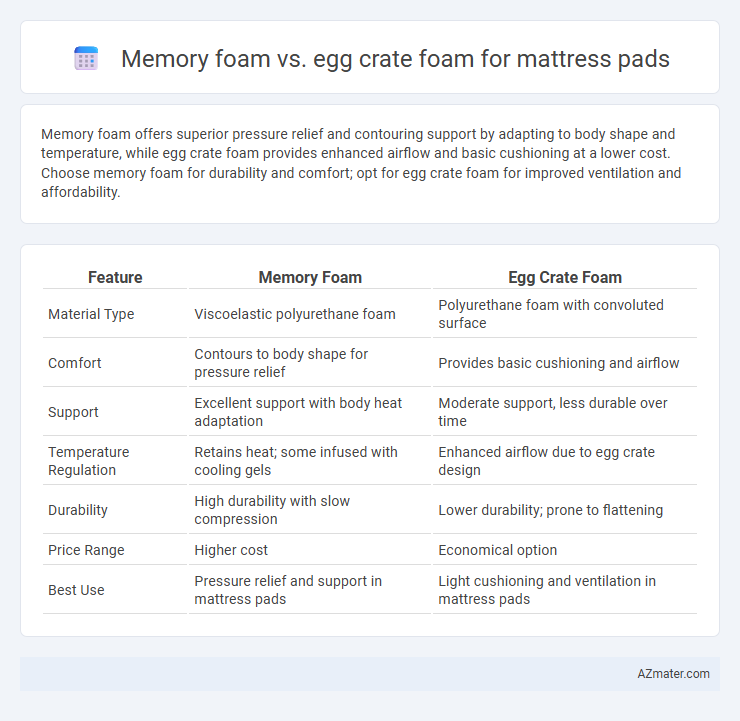Memory foam offers superior pressure relief and contouring support by adapting to body shape and temperature, while egg crate foam provides enhanced airflow and basic cushioning at a lower cost. Choose memory foam for durability and comfort; opt for egg crate foam for improved ventilation and affordability.
Table of Comparison
| Feature | Memory Foam | Egg Crate Foam |
|---|---|---|
| Material Type | Viscoelastic polyurethane foam | Polyurethane foam with convoluted surface |
| Comfort | Contours to body shape for pressure relief | Provides basic cushioning and airflow |
| Support | Excellent support with body heat adaptation | Moderate support, less durable over time |
| Temperature Regulation | Retains heat; some infused with cooling gels | Enhanced airflow due to egg crate design |
| Durability | High durability with slow compression | Lower durability; prone to flattening |
| Price Range | Higher cost | Economical option |
| Best Use | Pressure relief and support in mattress pads | Light cushioning and ventilation in mattress pads |
Introduction: Memory Foam vs Egg Crate Foam Mattress Pads
Memory foam mattress pads conform closely to body contours, providing enhanced pressure relief and support, which reduces the risk of pressure sores. Egg crate foam mattress pads feature a convoluted design that promotes improved air circulation and a mild cushioning effect, making them an affordable option for basic comfort and ventilation. Choosing between these mattress pads depends on individual needs for durability, pressure distribution, and breathability.
What is Memory Foam?
Memory foam is a viscoelastic polyurethane material known for its high density and ability to conform closely to body shape by responding to heat and pressure, providing superior support and pressure relief. Unlike egg crate foam, which is primarily shaped for ventilation and surface cushioning, memory foam adapts dynamically to body contours, promoting spinal alignment and reducing motion transfer. Its durability and pressure-distributing properties make it a preferred choice for mattress pads aimed at enhancing sleep comfort and reducing discomfort.
What is Egg Crate Foam?
Egg crate foam is a type of polyurethane foam characterized by its distinctive peaks and valleys, designed to enhance airflow and provide pressure relief. Unlike memory foam, which contours closely to the body by responding to heat and weight, egg crate foam offers a more breathable and lightweight option for mattress pads. This structure helps reduce heat retention and improves comfort, making egg crate foam suitable for individuals seeking moderate cushioning and increased ventilation.
Comfort and Support Comparison
Memory foam mattress pads provide superior comfort by contouring to the body's shape, offering excellent pressure relief and support, which helps reduce pain and enhances sleep quality. Egg crate foam mattress pads improve airflow and provide moderate cushioning with their distinctive peak-and-valley design, making them a budget-friendly option for basic comfort and pressure distribution. Memory foam's higher density and slow responsiveness create more durable and effective support compared to the lightweight, less supportive structure of egg crate foam.
Pressure Relief: Which Pad Performs Better?
Memory foam mattress pads provide superior pressure relief by contouring closely to body curves, distributing weight evenly, and reducing pressure points. Egg crate foam offers moderate cushioning but tends to be less effective at conforming to individual body shapes, resulting in uneven support. For targeted pressure relief and enhanced comfort, memory foam outperforms egg crate foam mattress pads.
Durability and Longevity
Memory foam offers superior durability and longevity compared to egg crate foam due to its high-density composition and ability to retain shape over extended periods. Egg crate foam, while more affordable and breathable, tends to compress and degrade faster, reducing its effective lifespan as a mattress pad. For long-term use, memory foam maintains consistent support and comfort, making it a more resilient choice for mattress padding.
Temperature Regulation and Breathability
Memory foam mattress pads offer excellent support but tend to retain heat due to their dense structure, which can reduce breathability and cause discomfort during warm nights. Egg crate foam, characterized by its convoluted surface, promotes better airflow and enhances temperature regulation by allowing heat to dissipate more effectively. Choosing egg crate foam is ideal for sleepers seeking improved breathability and cooler sleeping conditions compared to traditional memory foam mattress pads.
Allergen and Odor Considerations
Memory foam mattress pads often contain synthetic materials that can emit a noticeable chemical odor initially, which may cause discomfort for allergy-sensitive individuals, while egg crate foam is typically made from polyurethane, potentially releasing fewer VOCs but can still harbor dust mites if not properly maintained. Both materials require regular cleaning and protective covers to minimize allergen accumulation, with memory foam offering denser, less porous surfaces that resist dust mite infiltration better than the more open structure of egg crate foam. Choosing hypoallergenic covers and ventilated designs enhances odor control and reduces allergen exposure for both memory foam and egg crate foam mattress pads.
Price and Value for Money
Memory foam mattress pads typically cost more than egg crate foam due to their advanced viscoelastic properties and superior pressure relief. Egg crate foam is generally less expensive and offers basic cushioning but lacks the durability and support of memory foam. For value-conscious buyers, memory foam provides better long-term comfort and durability, while egg crate foam is a budget-friendly option with limited longevity.
Choosing the Right Mattress Pad: Final Thoughts
Memory foam mattress pads provide superior support and pressure relief by contouring to the body's shape, making them ideal for individuals with joint pain or those seeking enhanced comfort. Egg crate foam, characterized by its convoluted surface, offers improved airflow and basic cushioning at a more affordable price point, suitable for lighter use or temporary bedding. Choosing the right mattress pad depends on personal comfort preferences, budget considerations, and specific needs such as motion isolation or temperature regulation.

Infographic: Memory foam vs Egg crate foam for Mattress pad
 azmater.com
azmater.com